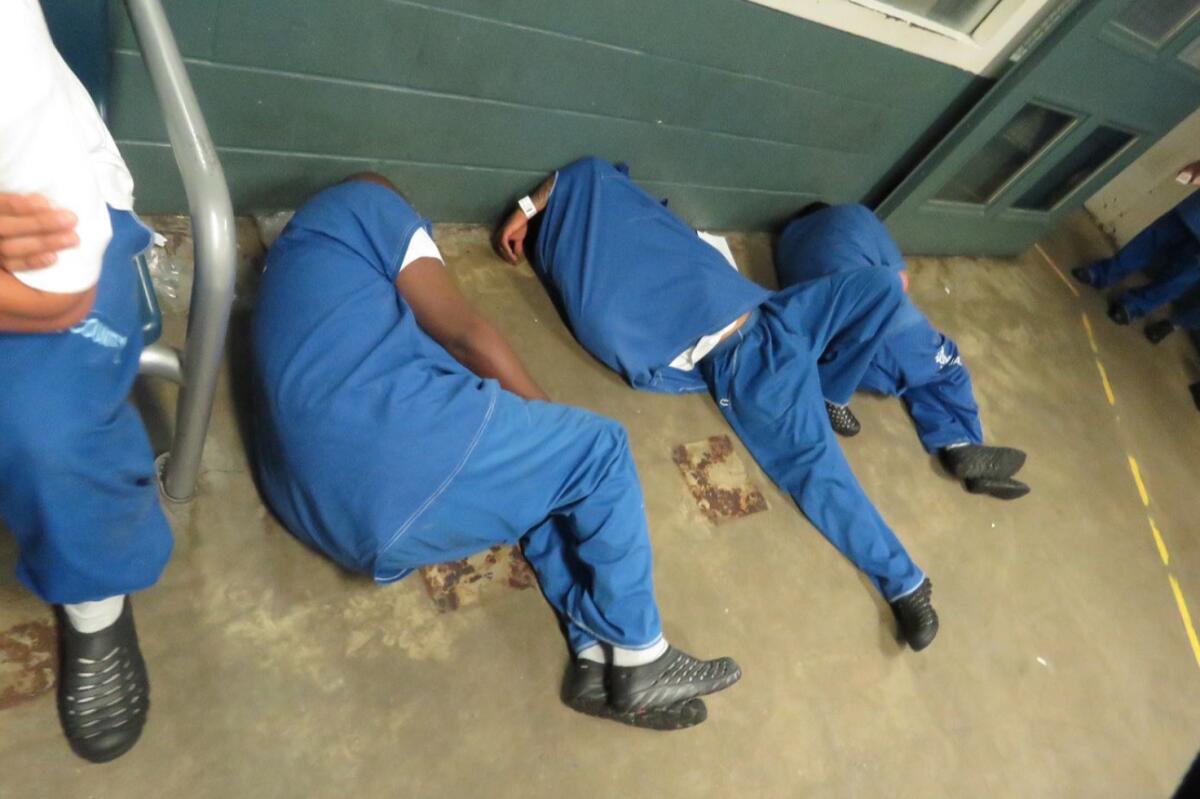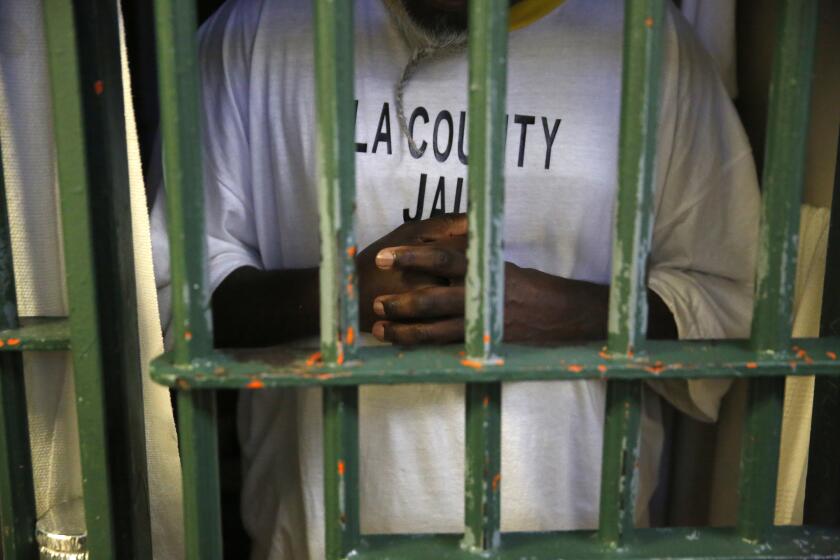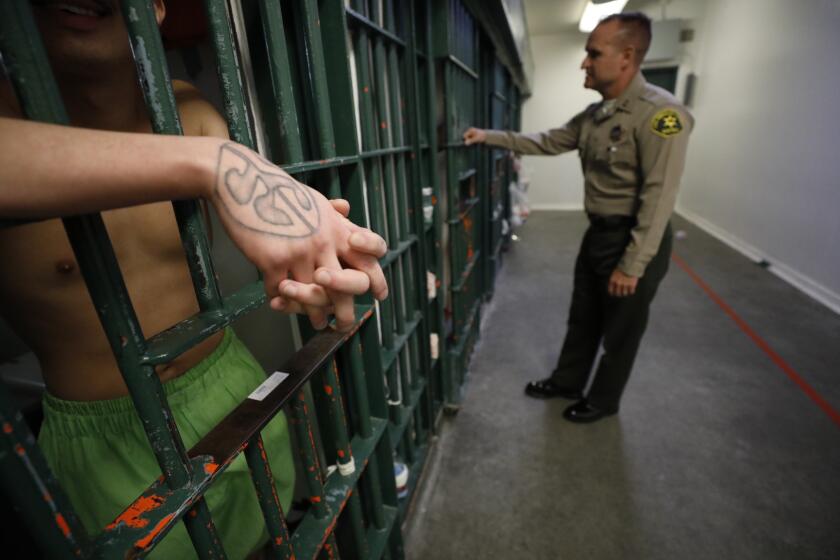Editorial: Unconscionable abuse and shameful inaction at L.A. County jails

- Share via
Rutherford vs. Luna is a long-running federal civil rights lawsuit challenging subhuman conditions inside Los Angeles County jails. The plaintiffs won the case decades ago, in the sense that a federal court concluded that even a short stay subjected unfortunate jail occupants to cruel and unusual treatment in violation of the U.S. Constitution (“punishment” is the wrong word to use here, because more than half of the people in jail are awaiting hearings and have not been convicted or sentenced).
Yet the plaintiffs keep losing, over and over, to the sheriff, the Board of Supervisors and other defendants because the court’s ongoing supervision over nearly a half-century (with each new sheriff named as a defendant in the continuing lawsuit) has somehow permitted conditions to slide from bad to horrific to utterly unconscionable.
Last fall, the plaintiffs’ attorneys at the ACLU Foundation of Southern California obtained an order banning custody practices that would spark international outrage if they were perpetrated by enemies in wartime: chaining or handcuffing mentally ill people to chairs for days without access to drinking water, toilets, showers, adequate ventilation or medication, and leaving them to sleep on concrete floors at the Inmate Reception Center with no mattresses or blankets, amid one another’s excrement.
Attorneys returned to court in March, arguing that the county was concealing its barbaric treatment by moving new arrivals to corridors and other out-of-view places.
The money bail system betrays a host of fundamental American values, including the presumption of innocence, the right to counsel and equality in the eyes of the law.
Several days later, the defendant Board of Supervisors refused to even discuss proposals by two supervisors, Hilda Solis and Lindsey Horvath, to transfer thousands of jail occupants to community mental health clinics, supportive housing or state prison. There was nothing in the package that had not been previously approved in concept by the board, ordered by courts (in Rutherford and other civil rights cases) or embraced by voters in Measure J, a county ballot measure more than two years earlier.
But the motion was so long and comprehensive, and it used such alarming words as “depopulate” — although that is a standard jail management term — that it became red meat for law enforcement unions and others on the political right. Pundits warned of dangerous mass releases of violent felons, although no such release was proposed. They warned of a supposed new “catch-and-release” policy for arrests, although release without bail for many crimes is a standard criminal justice practice around the nation, including Los Angeles County. They depicted common-sense measures for addressing the humanitarian crisis in the jails and enhancing public safety on the streets as a potential new wave of violent crime.
A disappointing number of news outlets moved swiftly past the facts and stoked public fears, forgetting that the board can’t actually release anyone from jail, but can only try to fund or encourage alternatives. Supervisors Janice Hahn and Kathryn Barger, both facing reelection next year, let law enforcement leaders know they wanted no part of the motion. Solis and Horvath pulled it.
A day after that failure, members of the county’s Sybil Brand Commission for Institutional Inspections failed to muster a quorum. Still, the members who showed up listened as a representative of the county’s Department of Public Health explained his office’s box-checking role in conducting jail inspections, with apparently no authority to order remedies. The state panel to which it files its reports can’t order fixes either.
The decrepit lockup facility was to close today under Board of Supervisors’ two-year timeline, but it remains full with no end in sight.
Commission Vice Chair Alex Sherman described to the virtually empty meeting room how during his recent inspection he watched an inmate reach under his bed frame and pull out a handful of live cockroaches, and how he observed cells smeared with feces going uncleaned from one unannounced visit to the next. He said he complained to the Sheriff’s Department, which blamed the medical staff and private contractors for failing to send cleaning crews. But it was not clear whether anyone was responsible for fixing the problem. Another commissioner lamented that the body has little power to do anything about the appalling situation except write a letter to the Board of Supervisors.
Meanwhile, in a nearby courtroom, in the case of Urquidi vs. City of Los Angeles, criminologists testified that scientific research demonstrates to a 95% degree of certainty that jail is criminogenic, meaning that incarceration makes a person more likely to be arrested for new crimes. They presented overwhelming evidence from peer-reviewed studies in Kentucky, New Jersey, Philadelphia and other jurisdictions that a zero-dollar bail schedule — allowing pretrial release of people arrested for nonviolent crimes, as was the practice in Los Angeles County from the beginning of the COVID lockdowns until last year — brings reduced crime and greater public safety.
Lawyers for the city of L.A. and the county, and the city’s police witness, practically conceded the point. But instead of agreeing to return to zero-dollar bail, they persist in fighting the case.
While experts testified in early May, and the Sybil Brand Commission canceled its meeting, and boxes were checked and reports filed, a United Nations human rights panel toured the jails. The county’s Civilian Oversight Commission conducted a conference on life inside one of the cells. It was welcome scrutiny; or, if things don’t change, perhaps mere oversight theater.
Few if any current jail occupants had been born when the Rutherford case alleging unconstitutional conditions was originally filed in 1975. Of the sheriffs successively named as defendants over the life of the lawsuit, two have died, one served prison time, one returned to Orange County and two were defeated for reelection.
A ruling in the Urquidi bail case is expected this week, but may be followed by settlement talks, leaving the parties close to where they were six weeks ago, before hearings on the request for a preliminary injunction against the money bail schedule began.
The Rutherford court set a hearing for June 27 on whether to hold Sheriff Robert Luna and county supervisors in contempt, and to fine them daily until the violations cease.
In the meantime, jail conditions worsen, elected officials cower, demagogues spout fantasies about criminal hordes, and desperately sick people enter jail to lie for days in their own waste and eventually emerge (if they survive) untreated, more broken and more dangerous. The numbers show us irrefutably that not only those in the jail but the rest of the people in this county will be safer when we release more people to more suitable quarters and care. At this rate, though, that may not happen until sometime in the next half-century.
More to Read
A cure for the common opinion
Get thought-provoking perspectives with our weekly newsletter.
You may occasionally receive promotional content from the Los Angeles Times.












